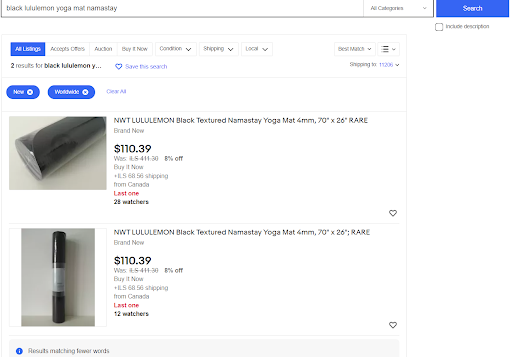Findability and discoverability on marketplaces

Both discoverability and findability are important, as they serve a slightly different purpose and different types of buyers - browsers and searchers. Here are a few tips how to improve listings’ discoverability and findability on marketplaces.
Generally speaking, eCommerce shoppers can be divided into two groups: browsers and searchers. For browsers, online shopping replaces the real-life window shopping experience and many of them don’t have a specific shopping intent at the beginning of their session on site. Their hope is to discover something they want to buy. Searchers, on the other hand, have a fairly firm idea of what they want to buy. When they visit an online store, they are most likely to use the search functionality to find the desired products.
While browsers rely on products’ discoverability, searchers rely on their findability, each requires a different approach. Discoverability means the ability of shoppers to discover products they were not specifically looking for or were not even aware of. Findability means whether or not shoppers can find the specific product they are looking for. They know the store sells this product, and it is just a matter of finding it easily.
Naturally, it is easier to test and assess a product’s findability - simply check how easy it is to find it when looking for it specifically. When it comes to assessing discoverability, the fact that we rely on shoppers discovering the product by chance, makes it more difficult to assess, so sellers have to rely more on analytics data.
Though different, both discoverability and findability are important, as sellers want to cater to both browsers and searchers. Here are a few tips how to improve your listings’ discoverability and findability on marketplaces:
Findability
The key to a product’s findability is placing it where shoppers (and specifically searchers) expect to find it. Remember, we are dealing with shoppers who know exactly what they are looking for, so all the information provided should be accurate and complete, giving them the confidence that this is indeed the product they are after.
- Place products in the correct category: whether in a search query or site navigation, placing products in the correct categories is crucial. Both the marketplace search engine, and shoppers using site navigation use category as the first (and sometimes the only) filter. Products that are placed in an incorrect category, or not categorized at all, will not appear in such relevant places. Placing each product in its correct category ensures that shoppers who look for it can find it.
- Use accurate images: the first thing shoppers look at is the listing’s image. Using accurate images can help them find the product they are after simply from looking at the product’s image in the results page. In this case, it is always better to use high quality images that both present the product better and inspire confidence.
- Give proper titles: the title is as important as images, as it is one of the first things shoppers look for in the listing. Using a proper title - both informative and engaging - is key. Proper titles provide the interested shoppers with the information they need to determine whether this is the product they are looking for. Using confusing or misleading titles might cause shoppers to move on to the next listing without realizing that this was actually what they were looking for.
- Using product identifiers: this is the highest level of findability optimization, as it caters to the most confident searcher. Product identifiers are a unique series of numbers and letters used to identify specific products, and each product has its own unique identifier. Sellers can include their products’ identifiers in the product description, so that shoppers who are looking for a very specific product can be sure that they have found the correct one by comparing product identifiers.
Discoverability
The key to a product’s discoverability is placing it in noticeable or relevant places, for instance, the top of the search results page, or near similar listings. However, since sellers do not have real control of where their listing is going to appear, they might take some actions that will help improve the listing’s discoverability.
- Tagging the product: As mentioned above, browsing shoppers like to see what is on sale, scan listings, and hope something catches their eye. Many of them use site navigation in order to refine results to more manageable numbers. When looking for sunglasses, for instance, shoppers can choose to see only red Prada women’s sunglasses. In order for the navigation to work properly and for relevant products to come up after the refinement, the products must be tagged with all of their appropriate attributes. Failure to do so will cause the product to disappear from the navigation results, and its discoverability to vanish.
- Attractive Price: Discoverability is about making shoppers notice your listings, and what better way to do that than offering attractive prices? Everybody knows that price is a major factor in the decision to purchase, and that many sellers sort the results by price. As much as they are able, sellers are advised to offer competitive prices that will contribute tremendously to discoverability.
- Free Shipping: Marketplaces love sellers who offer free shipping, because this means a much better shopping experience. So much so, that in most marketplaces, listings that offer free shipping are promoted to prominent places in the results page, making them much more discoverable to shoppers.
- Using attributes in the title: As mentioned above, the listing’s title is one of the first things shoppers see, and therefore it is crucial. In order to improve discoverability, it is recommended to include in the title the product’s main attributes, so that it can attract the eye of a browser. To ensure a high conversion rate, as always, the information must be accurate and complete.
- Splitting variations: Some marketplaces offer sellers the option to choose between a listing with variations and a listing without variations. A listing with variations means Sellers can add up to 5 variation attributes, such as size, color, type, compatibility, in a single listing, while in a listing without variations a single specific product is sold, with no varying attributes. While the first has its benefits, for the purpose of increasing discoverability, it is better to use listings without variations. The reason for this is simple - if we want people to notice our listings, it is more useful to create a number of listings and spread them all over the results page, rather than posting one single listing that might be looked over.
Despite the differences between them, discoverability and findability are still connected, and shoppers can move quickly between finding and discovering products, without even realizing it. For example, a shopper, a searcher, is looking for a very specific kind of yoga mat, and searches for it on eBay. Now findability comes into play in locating the specific product. 
Other than exact matches for the search query, eBay also presents results that match fewer search words, and among them the shopper discovers to his pleasant surprise the same yoga mat, only in a different color, and more importantly, much cheaper! 
This is what discoverability is all about - helping shoppers discover products they were not specifically looking for, but are relevant to them. In this example we can see how discoverability and findability are connected and sometimes come into play together in the same shopping journey.



